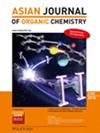A Synthetic Approach to Singlet Phospholo[3,4‐c]thiophene Biradicals via the Conversion from Phosphole to Thiophene
IF 2.8
4区 化学
Q1 CHEMISTRY, ORGANIC
引用次数: 0
Abstract
This paper proposes a molecular design for open‐shell singlet biradicals through a synthetic study of phospholo[3,4‐c]thiophenes in which the phosphole ring is fused with thiophene. The sulfur‐bridged diyne was converted into the titanacycle intermediate, and the subsequent treatment with chlorodiphenylphosphine provided the corresponding phosphole via the [2+2+1] cycloaddition process. The −CH2SCH2‐bridged phosphole oxide could be isomerized to the corresponding thiophene structure probably because of the larger aromaticity of thiophene rather than phosphole. The 4,6‐dihydrophospholo[3,4‐c]thiophene 5‐oxide derivative was triflated to give the thiophene‐fused cyclic phosphonium salt, which could generate the desired singlet biradical by treatment with potassium hydride. In addition, pai‐extension of the 4,6‐dihydrophospholo[3,4‐c]thiophene 5‐oxide unit using the Pd‐catalyzed cross‐coupling reaction with arylstannanes was accomplished, and the resultant isolable 5,6‐dihydro‐4H‐phospholo[3,4‐c]thiophene derivatives showed potent characters as precursors of singlet biradical. The generation of biradical phospholo[3,4‐c]thiophenes was supported by the [4+2] trapping reaction and the 1,2‐migration leading to a cyclic phosphaalkene.

通过从磷洞到噻吩的转化合成单磷洞[3,4-c]噻吩双环化合物的方法
本文通过对磷环与噻吩融合的phospholo[3,4-c]噻吩的合成研究,提出了一种开壳单子双激化物的分子设计。硫桥二炔被转化成钛环中间体,随后与氯二苯基膦处理,通过[2+2+1]环加成过程提供了相应的磷环。可能是由于噻吩的芳香性大于磷烯,所以-CH2SCH2-桥接的磷烯氧化物可以异构化成相应的噻吩结构。4,6-二氢磷[3,4-c]噻吩 5-氧化物衍生物经三氟化后得到噻吩融合环状鏻盐,该盐经氢化钾处理后可生成所需的单双拉子。此外,利用钯催化的交叉耦合反应,4,6-二氢-4H-磷酸[3,4-c]噻吩 5-氧化物单元与芳基锡发生了对延伸反应,由此分离出的 5,6-二氢-4H-磷酸[3,4-c]噻吩衍生物显示出作为单子双辐射前体的强大特性。双辐射磷[3,4-c]噻吩的生成得到了[4+2]捕获反应和导致环状磷烯的 1,2 迁移的支持。
本文章由计算机程序翻译,如有差异,请以英文原文为准。
求助全文
约1分钟内获得全文
求助全文
来源期刊

Asian Journal of Organic Chemistry
CHEMISTRY, ORGANIC-
CiteScore
4.70
自引率
3.70%
发文量
372
期刊介绍:
Organic chemistry is the fundamental science that stands at the heart of chemistry, biology, and materials science. Research in these areas is vigorous and truly international, with three major regions making almost equal contributions: America, Europe and Asia. Asia now has its own top international organic chemistry journal—the Asian Journal of Organic Chemistry (AsianJOC)
The AsianJOC is designed to be a top-ranked international research journal and publishes primary research as well as critical secondary information from authors across the world. The journal covers organic chemistry in its entirety. Authors and readers come from academia, the chemical industry, and government laboratories.
 求助内容:
求助内容: 应助结果提醒方式:
应助结果提醒方式:


